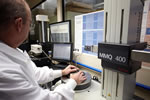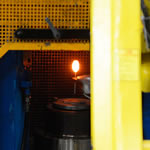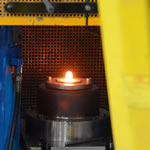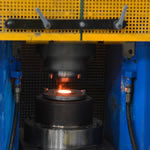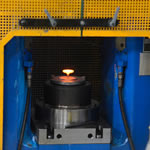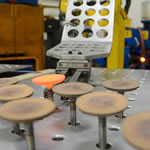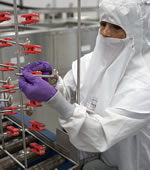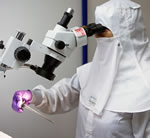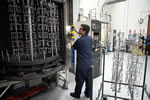Making Titanium Valves
by Hib Halverson
© May 2013
No use without permission, All Rights Reserved
In researching titanium intake valves, I learned that not only was the LS7 their first use in a production engine, it remains the only one. There are some limited production motorcycles using them. Toyota tried Ti valves, done with powered metal technology, in limited production Lexus applications in the early-'00s but that didn't end well. Other OE's in the high-end engine market are said to be developing them, but currently, only General Motors is using a Ti valve in a production car.
Unless you're a hardcore racer, prior to reading our story on LS7, you probably never heard of Del West Engineering, but the motorsports community sure knows Del West. Of teams racing at the upper levels of Motorsports—F1, NASCAR Sprint Cup, 24-Hrs of Le Mans, Indy 500 and etc.—90% of them use Del West titanium valves. That's an amazing figure. Not often does one manufacturer of a specific part dominate a market so completely. That piqued our curiosity, so we paid a visit to Del West in Valencia, California. Managing Director, Mark Sommer sat down with us for an interview and Marketing Manager, Shannon Decker gave us a tour of the company's two manufacturing facilities.
It was Corvette racer Dick Guldstrand who conceived the idea of a titanium valve. Del West began as an aerospace testing and inspection business but switched to manufacturing in 1978 when it developed a Ti valve at Guldstrand's suggestion—ironically, for a drag racing Corvette. It takes a while for innovation to catch on, but by the late-'80s/early-'90s, F1, Indianapolis racers and, especially NASCAR, were using valves of the lightweight metal to enhance the high-RPM reliability of their engines. Every time I see telemetry on TV of Sprint Cup engines turning 9200 RPM down the straight, I'm astonished. With all the mass of a pushrod valvetrain—no wonder they use Ti valves.
In 2000, when Corvette Racing went to a seven-liter engine, Katech used titanium intake and exhaust valves to reduce valvetrain mass. As the early stages of LS7 development progressed and GM Powertrain studied what Katech had done with the C5-R cylinder head, it was inspired by the Ti intake valve.
"We were supplying the Corvette Le Mans program and there was no one in the world making production titanium valves at the time," Mark Sommer told us. "They came to us about 14 months before SOP and said, 'Why don't you make titanium valves for the (Z06). We said, 'Great. How many?' The numbers were ridiculous—they wanted to pay nothing. We finally found an agreeable price. Cheaper than we wanted to be. Much more expensive than they wanted to be. That all happened within two or three months because they were in full panic mode trying to meet the 500-horsepower goal."
As it turned out, the design/engineering phase of doing a 2.2-in. valve for a production application was not difficult for Del West because, as Mark Sommer, continued "...the inlet valve that went into the Corvette Le Mans engine is really close in size. So is the valve we do for NASCAR—a little skinnier, because reciprocating mass is everything, but it's really close."
While Del West Ti valves for NASCAR and endurance road racing had a reputation for performance and reliability, learning to make a Ti valve for a production application, where quality and cost demands are, also, key concerns, was no picnic. "We had to rethink how we were doing the valve when we went to production," Sommer added, "The racing part was meant to be done very quickly with (capability for) rapid change in design. They'll (NASCAR Sprint Cup teams) call us and say, 'We were playing around on the dyno and it turns out we think we want you to change such-and-such and can you do it in three weeks?' We had to do just the opposite with GM. They qualify the process, then don't want you to change anything.
"We weren't certified to any quality management systems like ISO9000. We simply had a quality system that worked for us built around rapid change. We held that in high regard—we can change in an instant, we can innovate, we can adapt on the fly. We were telling this to GM in 2004 when Jim (Hicks) was talking with us. Jim thought this was great. Then the quality expert, Dave Charboneau, came in here and was horrified. We were told, 'You'll develop a procedure, we're going to certify it and then you'll never change it.' We eventually became qualified to 'Quality Systems Basic' which is GM's internal quality system and is one step beyond ISO and that was coming from us not even being ISO.
"That was a big change for us. About a mile and a half away, we actually built a facility specifically to work on the LS7 valve. Today, it's also doing stuff for (motorcycle manufacturers) KTM, Ducati, BMW and MV Agusta, so it's grown, but we set it up specially for the LS7 work because we were afraid we'd taint the two—we were afraid we would get to where, on the racing stuff, we would become too locked into place and we were afraid we'd run our costs through the roof on the GM side.
"So much of the changes we have in (our processes for) racing were driven by what's happened in serial production. We thought all this racing would teach us how make production parts. It turns out, the production parts taught us how to make better race parts. You can measure them 100% and call out the bad. We used to do that. A customer would need 100 parts. We'd make 115. At the end, we'd measure them, find six bad parts, throw them out, ship the customer 100 and have nine left over. That is not how we operate any more. GM wanted to make sure we understood exactly what was going on with every single process. We had to measure, measure, and measure some more. Now, we better control the process and have very little rejection at the end. The old way was: a) really expensive and b) was potentially dangerous because you can have a huge mistake where you won't find the problem.
"I would say we would not be where we are today if we had not been beat up one side and down the other by GM's quality group. We hated them at the time. Dave's a great guy, but we were ready to throttle him for the total pain in the rear he was being, but...did he end up getting GM, and by definition the Corvette customer, a better product? Absolutely, yes!"
And has doing LS7 intake valves made Del West a better manufacturer? Precisely. We found that out in the tour Shannon Decker gave us of the LS7 production area.
The titanium Del West uses is a proprietary variation of the common "6-2-4-2" Ti alloy. It comes to Del West as long pieces of bar stock. They're cut to length and dropped into a tray on the side of a cage containing a robot. I was amazed at how much robotics were a part of the Ti valve production process. There are a variety of reasons Del West has converted some parts of its production to robots but the key ones are: 1) they are very precise in positioning parts during the manufacturing process, 2) they work faster and 3) they improve safety.
At this point the valve-to-be is just a short titanium rod. The robot places the rod in a fixture which passes electrical current through one end heating it until that end glows bright yellow. The fixture also forms the glowing end into a blob. Then, the robot picks the part out of the heater and places it, stem down, on one half of a forging die housed in a press adjacent to the furnace.
BAM! The other half of the die hits the glowing blob with 30-tons pressure, forging the valve head. You can feel the impact through the floor The robot picks the red hot valve out of the press and sets it in a cooling tray. The tray of valves is moved to an area where they are machined by robots with the last step grinding the 45° face. Then the valves are polished.
Now comes the hard part: applying the chrome-nitride (CrN) coating. One stringent requirement of the coating process is absolute cleanliness. First, the valves are moved into a "clean room" where the air is dust-free and everyone wears white suits covering everything except part of their faces. In the clean room, the valves are run though a four-step cleansing process with every step having a rinse between the next wash. After washing, the valves are hung in metal "trees".
The trees are moved into a 1.5-cubic-meter physical vapor deposition (PVD) chamber which applies the CrN coating. Inside the chamber is a big metal coil with a chrome bar through the center. The trees rotate one direction and they move in a track around the coil in the opposite direction. A voltage is applied to the center coil which causes arching and vaporizing of ions off the chrome bar. This occurs in a low-pressure nitrogen atmosphere. The chrome ions react with the nitrogen and a four micron (about .00016-in) chromium-nitride (CrN) coating is deposited on the valves very slowly. Each batch of 400 valves takes eight hours.
After they come out of the PVD chamber, they're packed and shipped to Linamar for use during the cylinder head assembly process.


